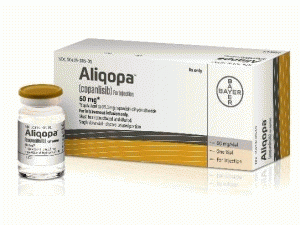冻干粉注射剂copanlisib(Aliqopa injection 60mg )
 产地国家:美国
处方药:是
所属类别: 60毫克/瓶
包装规格: 60毫克/瓶
计价单位:瓶
生产厂家英文名:Bayer
原产地英文商品名:Aliqopa injection 60mg/via
原产地英文药品名:copanlisib
中文参考商品译名:Aliqopa冻干粉注射剂 60毫克/瓶
中文参考药品译名:copanlisib
产地国家:美国
处方药:是
所属类别: 60毫克/瓶
包装规格: 60毫克/瓶
计价单位:瓶
生产厂家英文名:Bayer
原产地英文商品名:Aliqopa injection 60mg/via
原产地英文药品名:copanlisib
中文参考商品译名:Aliqopa冻干粉注射剂 60毫克/瓶
中文参考药品译名:copanlisib
简介
近日,靶向抗癌药copanlisib(商品名 Aliqopa 拜耳产品)获美国FDA加速批准上市,用于治疗罹患复发性滤泡性淋巴瘤,且已经接受了至少两次系统疗法的成人患者。这也是美国FDA今年批准的第10款抗癌新药。copanlisib是一种新颖的静脉注射型泛I类磷脂酰肌醇-3-激酶(PI3K)抑制剂,针对恶性B细胞中表达的PI3K-α和PI3K-δ异构体具有主要的抑制活性。 PI3K信号通路参与细胞的生长、存活和新陈代谢,该通路的失调在非霍奇金淋巴瘤(NHL)中发挥了重要作用。批次日期:2017年9月19日 公司:拜耳药品ALIQOPA™(copanlisib)用于注射,用于静脉注射最初的美国批准:2017年作用机制Copanlisib是磷脂酰肌醇-3-激酶(PI3K)的抑制剂,主要针对在恶性B细胞中表达的PI3K-α和PI3K-δ异构体具有抑制活性。 已显示Copanlisib通过细胞凋亡和抑制原发恶性B细胞系的增殖来诱导肿瘤细胞死亡。Copanlisib抑制几种关键的细胞信号传导途径,包括B细胞受体(BCR)信号传导,CXCR12介导的恶性B细胞趋化和淋巴瘤细胞系中的NFκB信号传导。 适应症和用法:ALIQOPA是一种激酶抑制剂,用于治疗复发性滤泡性淋巴瘤(FL)成人患者,这些患者至少接受过两次全身性治疗。根据整体回应率,该指征已获得加速批准。对该适应症的持续批准可能取决于验证试验中对临床受益的验证和说明。 剂量和给药:在28天治疗周期的第1,8和15天,以间歇方案(3周和1周后)以1小时静脉内输注的形式给予60mg。修改毒性剂量)。查看完整的处方信息以获取重要的准备和管理信息。剂型和强度用于注射:60mg作为冻干固体在单剂量小瓶中用于重建。 禁忌症:没有。 警告和注意事项: 感染:监测患者感染的症状和体征。3年级和更高的感染预防治疗直到解决。 高血糖症:一旦达到最佳血糖控制,开始每次输注。根据高血糖的严重程度和持续时间,停止治疗,减少剂量或停止治疗。 高血压:直到收缩压(BP)低于150 mmHg,舒张压低于90 mmHg,患者才接受治疗。如果需要抗高血压治疗,考虑减少剂量。停止使用不受控制或有生命危险后果的BP患者。 非感染性肺炎(NIP):治疗NIP并减少剂量。如果2级NIP复发或3级或更高NIP患者停止治疗。 嗜中性白血球减少症:在治疗期间至少每周监测一次血液计数。扣除治疗直至ANC≥0.5×10 3个细胞/mm 3。 严重皮肤反应:根据严重皮肤反应的严重程度和持续时间,扣留治疗,减少剂量或停止治疗。 胚胎 - 胎儿的毒性:ALIQOPA可能会对胎儿造成伤害。建议患者对胎儿有潜在风险并使用有效的避孕措施。 不良反应:最常见的不良反应(≥20%)是高血糖,腹泻,一般力量和能量下降,高血压,白细胞减少症,中性粒细胞减少症,恶心,下呼吸道感染,血小板减少症。 药物相互作用: CYP3A诱导剂:避免与强效CYP3A诱导剂共同使用。 CYP3A抑制剂:与强效CYP3A抑制剂同时使用时,将ALIQOPA剂量降低至45 mg。 在特定人群中使用:哺乳期,建议妇女不要母乳喂养。 储存:必须在2°C至8°C(36°F至46°F)的温度下冷藏。冷藏后,让产品在使用前适应室温。避免将稀释溶液暴露在阳光直射下。仅与0.9%NaCl溶液混合。不要将ALIQOPA与其他药物或其他稀释剂混合或注射[见剂量和给药]。英文版说明书:
Aliqopa (copanlisib injection)ALIQOPA (copanlisib) is indicated for the treatment of adult patients with relapsed follicular lymphoma (FL) who have received at least two prior systemic therapies.Accelerated approval was granted for this indication based on overall response rate. Continued approval for this indication may be contingent upon verification and description of clinical benefit in a confirmatory trial.Important Safety InformationInfections: Serious, including fatal, infections occurred in 19% of 317 patients treated with ALIQOPA monotherapy. The most common serious infection was pneumonia. Monitor patients for signs and symptoms of infection and withhold ALIQOPA for Grade 3 and higher infection.Serious pneumocystis jiroveci pneumonia (PJP) infection occurred in 0.6% of 317 patients treated with ALIQOPA monotherapy. Before initiating treatment with ALIQOPA, consider PJP prophylaxis for populations at risk. Withhold ALIQOPA in patients with suspected PJP infection of any grade. If confirmed, treat infection until resolution, then resume ALIQOPA at previous dose with concomitant PJP prophylaxis.Hyperglycemia: Grade 3 or 4 hyperglycemia (blood glucose 250 mg/dL or greater) occurred in 41% of 317 patients treated with ALIQOPA monotherapy. Serious hyperglycemic events occurred in 2.8% of patients. Treatment with ALIQOPA may result in infusion-related hyperglycemia. Blood glucose levels typically peaked 5 to 8 hours post-infusion and subsequently declined to baseline levels for a majority of patients; blood glucose levels remained elevated in 17.7% of patients one day after ALIQOPA infusion. Of 155 patients with baseline HbA1c <5.7%, 16 (10%) patients had HbA1c >6.5% at the end of treatment.Of the twenty patients with diabetes mellitus treated in CHRONOS-1, seven developed Grade 4 hyperglycemia and two discontinued treatment. Patients with diabetes mellitus should only be treated with ALIQOPA following adequate glucose control and should be monitored closely.Achieve optimal blood glucose control before starting each ALIQOPA infusion. Withhold, reduce dose, or discontinue ALIQOPA depending on the severity and persistence of hyperglycemia.Hypertension: Grade 3 hypertension (systolic 160 mmHg or greater or diastolic 100 mmHg or greater) occurred in 26% of 317 patients treated with ALIQOPA monotherapy. Serious hypertensive events occurred in 0.9% of 317 patients. Treatment with ALIQOPA may result in infusion-related hypertension. The mean change of systolic and diastolic BP from baseline to 2 hours post-infusion on Cycle 1 Day 1 was 16.8 mmHg and 7.8 mmHg, respectively. The mean BP started decreasing approximately 2 hours post-infusion; BP remained elevated for 6 to 8 hours after the start of the ALIQOPA infusion. Optimal BP control should be achieved before starting each ALIQOPA infusion. Monitor BP pre- and post-infusion. Withhold, reduce dose, or discontinue ALIQOPA depending on the severity and persistence of hypertension.Non-infectious Pneumonitis: Non-infectious pneumonitis occurred in 5% of 317 patients treated with ALIQOPA monotherapy. Withhold ALIQOPA and conduct a diagnostic examination of a patient who is experiencing pulmonary symptoms such as cough, dyspnea, hypoxia, or interstitial infiltrates on radiologic exam. Patients with pneumonitis thought to be caused by ALIQOPA have been managed by withholding ALIQOPA and administration of systemic corticosteroids. Withhold, reduce dose, or discontinue ALIQOPA depending on the severity and persistence of non-infectious pneumonitis.Neutropenia: Grade 3 or 4 neutropenia occurred in 24% of 317 patients treated with ALIQOPA monotherapy. Serious neutropenic events occurred in 1.3%. Monitor blood counts at least weekly during treatment with ALIQOPA. Withhold, reduce dose, or discontinue ALIQOPA depending on the severity and persistence of neutropenia.Severe Cutaneous Reaction: Grade 3 and 4 cutaneous reactions occurred in 2.8% and 0.6% of 317 patients treated with ALIQOPA monotherapy respectively. Serious cutaneous reaction events were reported in 0.9%. The reported events included dermatitis exfoliative, exfoliative rash, pruritus, and rash (including maculo-papular rash). Withhold, reduce dose, or discontinue ALIQOPA depending on the severity and persistence of severe cutaneous reactions.Embryo-Fetal Toxicity: Based on findings in animals and its mechanism of action, ALIQOPA can cause fetal harm when administered to a pregnant woman. In animal reproduction studies, administration of copanlisib to pregnant rats during organogenesis caused embryo-fetal death and fetal abnormalities in rats at maternal doses as low as 0.75 mg/kg/day (4.5 mg/m2/day body surface area) corresponding to approximately 12% the recommended dose for patients. Advise pregnant women of the potential risk to a fetus. Advise females of reproductive potential and males with female partners of reproductive potential to use effective contraception during treatment and for at least one month after the last dose.Adverse Drug Reactions: Serious adverse reactions were reported in 44 (26%) patients. The most frequent serious adverse reactions that occurred were pneumonia (8%), pneumonitis (5%) and hyperglycemia (5%). Adverse reactions resulted in dose reduction in 36 (21%) and discontinuation in 27 (16%) patients. The most frequently observed adverse drug reactions (≥20%) in ALIQOPA-treated patients were: hyperglycemia (54%), leukopenia (36%), diarrhea (36%), decreased general strength and energy (36%), hypertension (35%), neutropenia (32%), nausea (26%), thrombocytopenia (22%), and lower respiratory tract infections (21%).Drug Interactions: Avoid concomitant use with strong CYP3A inducers. Reduce the ALIQOPA dose to 45 mg when concomitantly administered with strong CYP3A inhibitors.Lactation: Advise women not to breastfeed. Advise a lactating woman not to breastfeed during treatment with ALIQOPA and for at least 1 month after the last dose.用药温馨提示:当您服用此药物时,需定期接受医疗专业人士的检查,以便随时针对其药效、副作用等情况进行监测。本网站所包含的信息旨在为患者提供帮助,不能代替医学建议和治疗。
药品价格查询,专业药品查询网站,药品说明书查询,药品比价 » 冻干粉注射剂copanlisib(Aliqopa injection 60mg )
药品价格查询,专业药品查询网站,药品说明书查询,药品比价 » 冻干粉注射剂copanlisib(Aliqopa injection 60mg )





